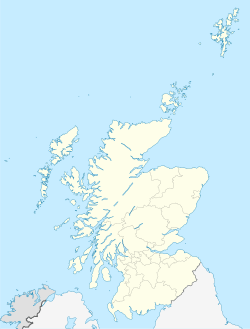Kirkton of Bourtie stone circle facts for kids
| Location | Aberdeenshire, Scotland |
|---|---|
| Coordinates | 57°18′50″N 2°19′56″W / 57.313998°N 2.332211°W |
| Type | Stone circle |
| History | |
| Periods | Neolithic / Bronze Age |
The Kirkton of Bourtie stone circle is an ancient and mysterious place in Aberdeenshire, Scotland. It's a special type of stone circle called a "recumbent stone circle." These circles were built a very long time ago, probably by people living during the Neolithic (New Stone Age) or Bronze Age. They are often found in the northeast of Scotland.
This stone circle is located about 4.4 kilometers (2.75 miles) northeast of Inverurie. It sits on a hillside that faces south, near the small village of Kirkton of Bourtie. The circle is on farmland, close to a small road, and is about 157 meters (515 feet) above sea level. You can clearly see the Hill of Barra to the north.
What is a Recumbent Stone Circle?
A stone circle is a monument made from large stones placed in a circle. A "recumbent stone circle" is a special kind of stone circle found mostly in northeast Scotland. It has one very large stone, called the "recumbent" stone, lying on its side. This stone is usually placed between two tall "flanker" stones. These circles were likely used for important ceremonies or to observe the moon and stars.
What's Left of the Kirkton of Bourtie Circle?
Sadly, the Kirkton of Bourtie stone circle is quite damaged. Only a few of its original stones remain. You can still see the eastern flanker stone, the large recumbent stone, and two stones on the western side.
The recumbent stone is broken, but it's still the longest one ever found! It measures about 5.2 meters (17 feet) long and 1 meter (3 feet 4 inches) wide. It's also very thick, with a measurement of 1.9 meters (6 feet 4 inches) around. This huge stone probably weighs more than thirty tons. It rests on a slightly raised area and is lined up with where the moon sets in the south.
The eastern flanker stone stands about 3 meters (9 feet 10 inches) tall. The two western stones are 1.8 meters (6 feet) and 2.4 meters (7 feet 9 inches) tall.
A Look Back in Time
It's believed that the circle originally had six or seven more stones. These missing stones might have been used in a nearby gate or wall. Inside the circle, you can still see small parts of what might have been ancient burial mounds, called cairns.
The area around the stones seems to have been used as a place to put natural stones cleared from the fields. An old report from 1867 mentioned a "rude pavement" inside the circle, but this has now completely disappeared. This pavement might have been the base of a cairn that is now gone.
The circle's damage might have happened not too long ago. In the late 1700s, a local minister named Rev Thomas Shepherd wrote that there were "three Druidical circles here, two of them pretty entire." About fifty years later, only two of those circles were left: Kirkton of Bourtie and the Sheldon stone circle. The Sheldon circle was said to be in "considerable preservation."
By the time the Ordnance Survey mapped the area in 1867, the Kirkton of Bourtie circle had only its current four stones. The map-makers noted that "No one [in] the parish remembers having seen it in any other condition than at present." The Office of Works officially protected the circle as an ancient monument in 1925. However, the land inside the circle was still being farmed until as recently as 1999.



